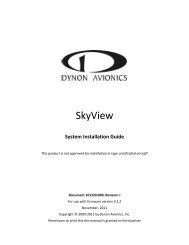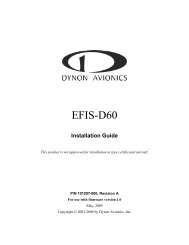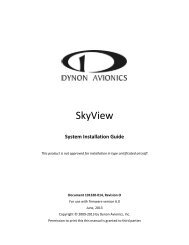EFIS-D100 Installation Guide - Dynon Avionics
EFIS-D100 Installation Guide - Dynon Avionics
EFIS-D100 Installation Guide - Dynon Avionics
You also want an ePaper? Increase the reach of your titles
YUMPU automatically turns print PDFs into web optimized ePapers that Google loves.
Autopilot <strong>Installation</strong> and Configuration<br />
loads, but low enough that the pilot can override the AP should the need arise. If the servo slips<br />
continuously, the AP cannot fly the aircraft. Torque is specified in % of maximum the servo is<br />
capable of exerting. Minimum: 10%, maximum 100%, default: 100%.<br />
On the <strong>EFIS</strong>, perform the following:<br />
If not already in the SETUP > AP menu, enter the menu and select PITCH SERVO and press<br />
SEL►<br />
(TORQUE value is highlighted)<br />
Press DEC - and INC + to adjust TORQUE to preferred initial setting for the aircraft.<br />
It may take some experimentation to find the right value for your aircraft, but if you are<br />
comfortable overriding the default value of 100%, it is safe to leave that setting at the default<br />
value. To test servo override, exit the SETUP > AP menu and return to the main <strong>EFIS</strong> menu.<br />
Center the aircraft controls. Enter the <strong>EFIS</strong> > AP menu and press ALTOFF. Note that the mode<br />
toggles to ALTON, the ALT bug synchronizes to the current altitude, and the pitch servo<br />
engages. Ensure that the controls do not deviate far from center.<br />
If you have an AP74 installed and configured, you can accomplish this same procedure<br />
by doing the following: Push the ALT button to ensure that it is lit; push the HDG button<br />
until it is not lit. Push the AP button to engage the AP in Altitude Hold mode.<br />
Now, take the controls and override the servo by moving to either pitch down or pitch up<br />
(remember, you are only overriding the pitch servo, so you should feel no resistance in the roll<br />
axis). Ensure that you are comfortable with the amount of force it takes to override the servo. If<br />
you are not, decrease the roll servo TORQUE value by 10% and repeat the test.<br />
Step 4b – Set Pitch Servo Sensitivity: The PITCH SERVO > SENSITIVITY parameter<br />
specifies the how fast or slow the AP responds to deviations between commanded altitude and<br />
actual altitude. If Sensitivity is set too low, the aircraft will “wallow” during changes in altitude.<br />
If Sensitivity is set too high, the aircraft will be “twitchy,” with frequent, fast, aggressive<br />
adjustments. Sensitivity is specified in digits. Minimum: 1 (low sensitivity), maximum: 25 (high<br />
sensitivity), default: 10.<br />
This parameter can be tuned in flight; leaving it at the default of 10 is sufficient for initial setup.<br />
If the autopilot is not as “decisive” as you’d like, increase this value; if it is too aggressive,<br />
decrease it.<br />
On the <strong>EFIS</strong>, perform the following (continuing from TORQUE):<br />
DOWN▼ > (SENSITIVITY value is highlighted)<br />
Press DEC - and INC + to adjust SENSITIVITY to preferred initial setting for the aircraft.<br />
Advanced Pitch Gain and Rate Adjustments<br />
There are several additional advanced parameters that can be used to fine tune the performance<br />
of the pitch axis. They should be considered secondary to the primary Pitch Axis Sensitivity<br />
adjustment. When used, they should be adjusted in the following order:<br />
Pitch Gain: Use only after sensitivity is set as well as it can be. Increase gradually if airplane<br />
does not settle on altitude. The default setting is 20.<br />
<strong>EFIS</strong>-<strong>D100</strong> <strong>Installation</strong> <strong>Guide</strong> 6-19
















